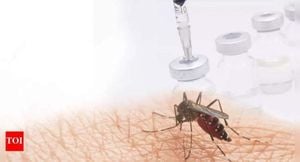When Owen Monroe was born, his heart was in trouble from the very start. The arteries that were supposed to carry blood from his tiny heart to his lungs and the rest of his body were fused together—a condition called truncus arteriosus. Within hours, he was in end-stage heart failure, kept alive only by a cocktail of intravenous medications. The odds were grim: conventional surgery for this defect carries a high risk, with nearly half of infants dying within a month and two-thirds within a year, according to The New York Times.
But in April 2022, Owen became a pioneer. Dr. Joseph Turek, chief of pediatric cardiac surgery at Duke University Medical Center, proposed a radical new approach: a partial heart transplant, using living valves and tissue from a donor heart to repair Owen’s own. It was a leap of faith—Dr. Turek had only performed the operation on piglets before. Yet, after eight hours in the operating room, the world’s first successful partial heart transplant in a human was complete. Owen, then just 17 days old, survived. Today, he’s a healthy preschooler, stacking blocks and running around the house, his mother says, “thriving and living his best life.”
This breakthrough is now the subject of a major new study published August 27, 2025, in the Journal of the American Medical Association (JAMA), led by Duke Health’s pediatric heart specialists. The research followed 19 patients, ranging from newborns to a 34-year-old adult, who received partial heart transplants at Duke between April 2022 and December 2024. Their conditions included truncus arteriosus, Tetralogy of Fallot, critical aortic stenosis, and other severe congenital heart defects. According to Inside Precision Medicine, congenital heart disease affects about 1% of U.S. births—roughly 40,000 babies each year—with many needing heart valve replacement.
Traditional options for children—mechanical or bioprosthetic valves—come with a major catch: they don’t grow with the child. That means repeat open-heart surgeries, sometimes three to five before adulthood, each riskier than the last. Scar tissue builds up, complications multiply, and every operation requires stopping the heart, raising the stakes even higher. As Dr. Taufiek Konrad Rajab, a cardiothoracic surgeon at Arkansas Children’s Hospital, told The New York Times, “Children born with valve defects often need multiple surgeries before they reach adulthood. Every operation is more complicated than the last.”
Partial heart transplantation, by contrast, uses living valves from donor hearts, which appear to grow with the patient. The Duke-led study found that, across all 19 cases, the transplanted valves maintained healthy function and grew in tandem with the child’s development, as measured by ultrasound. In the initial cohort, nine infants were followed for a median of about six months, and their valves doubled in size—a promising sign, though the researchers caution that longer-term data is needed.
The procedure isn’t just for infants. While most patients in the study were under a year old, older children and even one adult were included. And the technique itself is innovative: many of the operations were “domino” transplants, where one patient receives a total heart transplant and their old heart—often with healthy valves—is repurposed for others. Given that about 43% of donor hearts from children and young adults go unused, according to United Network for Organ Sharing data cited by Dr. Rajab, this approach could help address organ shortages and save more lives.
Of course, every transplant comes with trade-offs. Patients require immunosuppressant drugs to prevent rejection of the donor tissue, which can lead to infections, kidney damage, and other complications over time. But in the Duke study, the need for these drugs was greatly reduced compared to full heart transplants. Dr. Turek told The New York Times that patients were weaned down to about a quarter of the usual amount of immunosuppression. “That’s a huge win for these kids and their families,” he said. In one remarkable case, a child named Kix Soderblom had to stop taking anti-rejection medication altogether after developing an infection from an unrelated surgery. Still, his transplanted valve continued to grow and function normally. “It wasn’t a choice at all; we just had to do it,” Kix’s father, Zach Soderblom, explained. Weeks passed as the family waited anxiously, but the outcome gave hope that some children may not need lifelong immunosuppression.
Dr. Douglas Overbey, assistant professor at Duke and study author, emphasized the significance: “If we can reduce or even eliminate the need for [immunosuppressants], it’s a major step forward.” But, as Dr. David Kalfa at Nicklaus Children’s Hospital in Miami pointed out, more research is needed. In an analysis of eight patients at another center, most developed antibodies against the donated valve, which could be linked to worse function, though the data is still under review. Dr. Kevin Daly, a cardiologist at Boston Children’s Hospital, wrote in an editorial in JAMA that “careful longitudinal data collection on partial heart transplant recipients across multiple centers is urgently needed.”
The Duke study’s results are encouraging: all transplanted valves functioned well, and no patient needed reoperation due to valve failure. One patient did require a follow-up operation, but it was unrelated to the implanted valve. There were no significant complications from surgery or immunosuppression, and only mild valve regurgitation was observed in a few cases after discharge. Median operation time was just under five hours, with patients spending a median of nine days in intensive care and 13.5 days in the hospital, as reported by MedPage Today.
Yet, the road ahead is not without challenges. The study’s authors and outside experts alike stress that partial heart transplant is not a cure-all. “It is not a panacea but, rather, a promising step forward that requires further refinement,” the researchers wrote in their JAMA report. The biggest unknowns: how long the valves will last, whether growth will persist, and how to balance the benefits of living tissue with the risks of immunosuppression. Equitable allocation of donor valves is another concern, as is the need for more data on long-term outcomes.
Meanwhile, researchers around the globe are pursuing alternative solutions. Several groups are developing tissue-engineered or bioengineered heart valves that could grow with children without the need for immunosuppression. For instance, Berlin-based GrOwnValve has implanted lab-grown valves made from patients’ own cells in collaboration with the German Heart Centre at Charité Hospital, according to Inside Precision Medicine.
For now, partial heart transplantation remains a rare procedure, available at fewer than 10 hospitals in the U.S. But for families like the Monroes, it has been life-changing. “We’re just incredibly grateful for every moment we have with him,” Owen’s mother said. As the science advances, this innovative approach could reshape the future for thousands of children born with life-threatening heart defects—one beating heart at a time.





